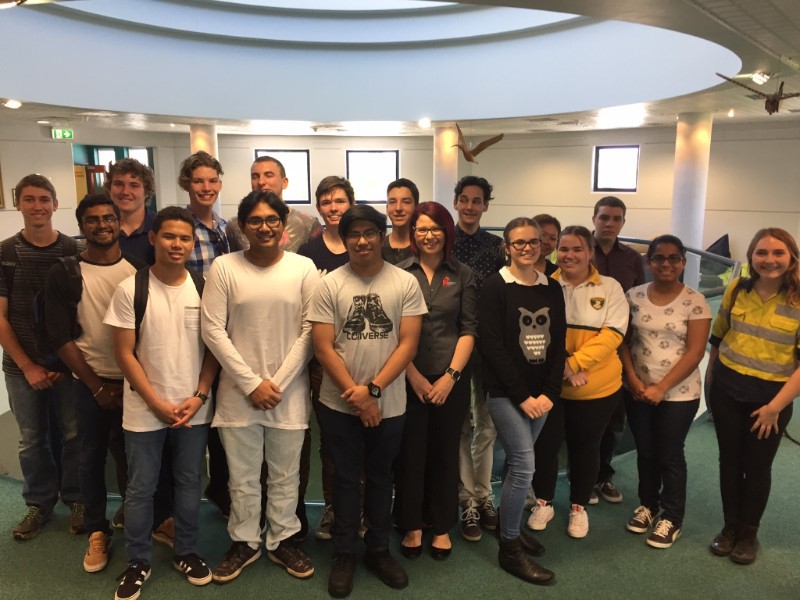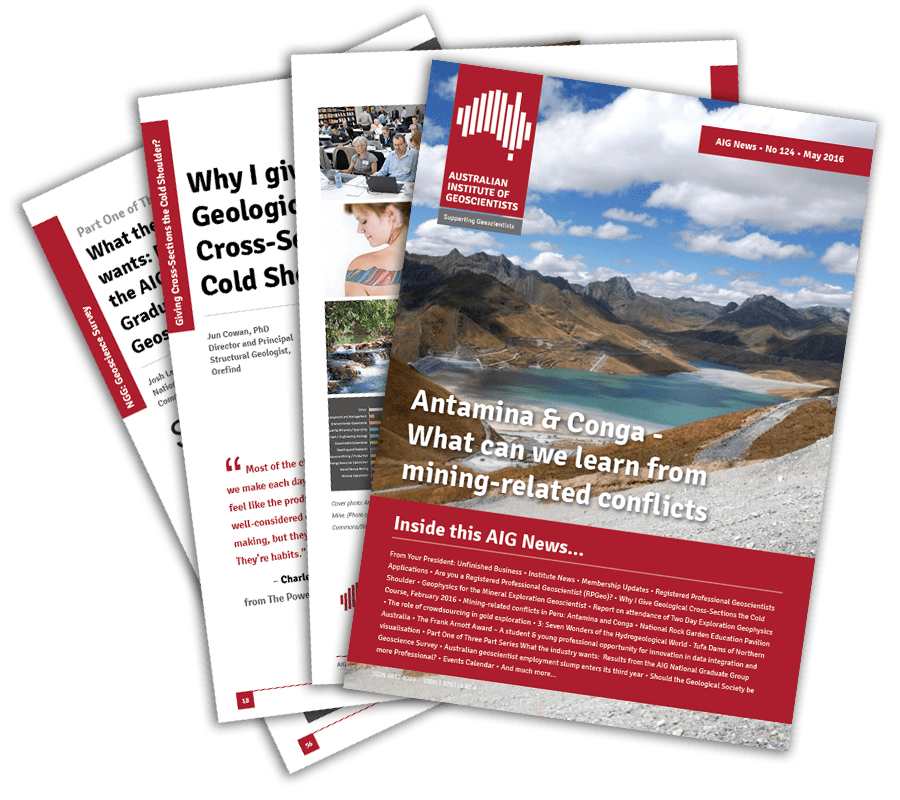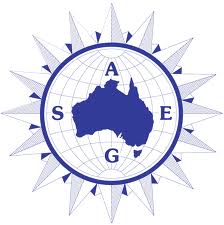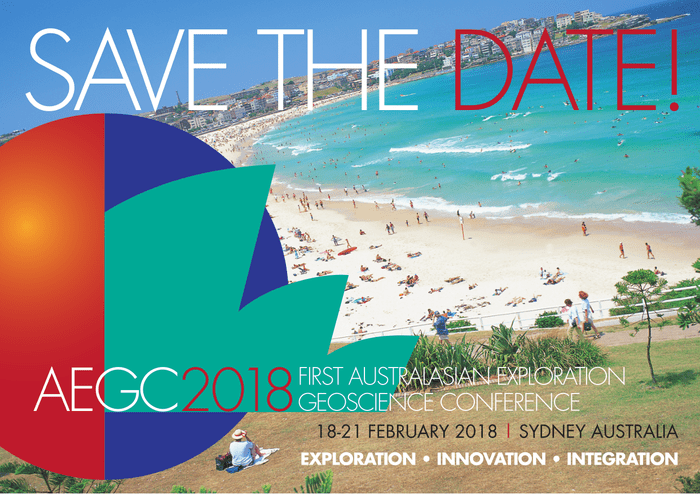Local students gathered at CQUniversity in Gladstone for a specifically designed two-day course to bridge their writing abilities between school and university and introduce them to the importance of safety in the resources sector.

The Introduction to Safety, Industry and Academic Writing course was provided by the Queensland Minerals and Energy Academy (QMEA) and CQUniversity to prepare students who are moving onto university. The course provides the Science, Technology, Engineering and Maths (STEM) students with an introduction to safety delivered by QGC, an onsite visit to local industry and one-to-one discussions with an engineering team. All of students took a lot out of the experiences and were thankful for the opportunity to take part in the course, especially with university just around the corner.
Queensland Resources Council Resources Recap, 30 September 2016
The Queensland Resources Council’s next Chief Executive will be former long-serving federal minister Mr Ian Macfarlane.
In announcing this appointment, incoming president of the Queensland Resources Council, Rag Udd, said that the board of the Queensland Resources Council was delighted to have secured the services of someone of the calibre of Ian Macfarlane.
‘Ian has had a distinguished career in the federal parliament and for most of that time served as a Minister or shadow Minister in portfolios which included responsibility for the resources sector,’ Mr Udd said.
‘Ian is much admired in the resources sector for his deep knowledge of and affinity for the sector. He has proven himself to be bipartisan in his approach to policy and advocacy.
‘Ian brings to the role a deep knowledge of bureaucracy, government and industry players, which means that he will be able to hit the ground running.’
Mr Udd said that Mr Macfarlane had extensive experience working in the industry association space. Prior to his 18 year career in federal politics, Ian spent nearly seven years as president of the Grain Growers Association in Queensland.
Mr Macfarlane said that, after a brief interlude since he retired from politics earlier this year, he was well and truly ready to tackle the challenges facing the resources sector in Queensland.
‘The Queensland Resources Council is a highly respected industry peak body on both sides of politics and throughout the wider community and I am honoured to be asked to build on the excellent work of outgoing Chief Executive Michael Roche,’ Mr Macfarlane said.
Mr Udd said that an induction and handover process will commence next month and Mr Macfarlane will formally take over as QRC Chief Executive on 17 November.
Queensland Resources Council Media Release, 26 September 2016
This week’s commencement of the Mineral and Energy Resources (Common Provisions) Act 2014 (MERCPA) in Queensland comes after a long two-year wait since the Act was passed.
‘The Act includes a set of complex legislative amendments over a range of areas of resource legislation including land access and changes to the restricted land framework,’ Mr Roche said.
‘The Act also provides for a new coal and coal seam gas overlapping tenure framework in Queensland. This new framework will help unlock areas for optimal co-development and maximise the resources extracted on behalf of the state.
‘Many Queensland tenures are overlapping, including in the resource-rich Bowen Basin and today’s commencement of the Act will provide a process that reduces delay to get access to the ground and start activities.’
Queensland Resources Council (QRC) CEO Mr Michael Roche said the new act provides a default agreement where parties could not otherwise come to an agreement.
‘QRC has been working with its members on the new overlapping tenure framework for more than five years and without their ongoing support and commitment this new framework would not have been possible,’ Mr Roche said.
‘The Act also amends the land access process by placing an obligation on resource companies to register on title Conduct and Compensation Agreements made with landholders. QRC supports this amendment given it may allow people to be more informed about likely resource activity on the land.
‘The creation of an opt-out agreement is also a welcome initiative, after it was recommended through several previous reviews to offer another choice to parties that seek a flexible approach without removing the existing right to compensate for impacts.
‘The intent of the voluntary opt-out agreement is to simplify the process of two willing parties who wish to strike an agreement outside a structured regime.
‘Importantly the opt-out agreement includes a series of protections to ensure this new flexible option is not used in a way that disadvantages either party.’
An information sheet on the opt-out agreement has to be provided to the landholder and there is also a 10-day cooling off period.
QRC Media Release, 27 September 2016
Engaging Science Grants support science engagement and communication projects, events and activities that increase the reach and impact of science in Queensland.
Applicants must:
More information about the grants programme is available here.
In AIG News 124 we talked about the thrill of our industry. How it can take you to places well off the beaten track, to places you never would have dreamed of going to. How it can challenge you both mentally and physically, working with people from all over the world who are enjoying the thrill just as much as you are. All of this while getting paid! Not a bad gig.
That’s all well and good for those who have the experience, skill and contacts to land that dream job, but how about for us early career geoscientists? (let’s call them ECgeos…it sounds cool…) What do we need to do to ensure we’re heading in the right direction in our careers, that we can survive the busts and thrive in the booms, land that dream job and have the career we’d hoped for?
That leads us into the topic of the next part of our series, covering the skills/traits considered valuable to employers, a topic of focus for the AIG National Graduate Group Geoscience Survey. As we did in AIG News 124, we’ll present the results from the survey and highlight the 4 common themes of Network, Attitude, Experience and Continuing Professional Development, revealed from the response.
Eight of the ten questions in the survey were targeted directly at discovering what skill/traits are essential for ECgeos. A list of all the relevant questions, their responses and some key comments are provided below.
Q1: What advice do you wish you were given during your early development?
Q2: What’s the best piece of advice you’ve been given?
Q4: What traits do you seek when looking to employ a graduate?
Q5: What advice can you offer to those wanting to survive the ‘busts’ and thrive in the ‘booms’?
Q6: Many students and graduates are concerned about the current downturn. What would you say to a student or graduate about that concern?
Q7: What are some of the most useful things you learnt during your time at university studying geology?
Q8: What level of study (i.e. Bachelor, honours, master and/or PhD) would you recommend and why?
Q9: Which geoscientist has been the most influential during your career and what did you learn from them that influenced it so greatly?
It may be stating the obvious but if you really want to do well in this industry (or any industry for that matter), it helps to love what you do. When our superiors were asked what they seek when employing a graduate, they overwhelmingly shouted words like enthusiasm, passion, initiative, inquisitiveness. Of course they did! Who wants to employ someone who doesn’t want to work for them? My guess would be no one. In fact, the theme of initiative and passion ran through most of the questions and that might be because it could be the difference between sinking or swimming when things get difficult. Imagine a common scenario where you’re in the middle of nowhere, mapping or drilling in the stinking hot sun, flies in your face constantly. You might not like it too much in that moment. But what if you were so intrigued with the story the rocks were telling you, that you didn’t really think too much about the heat or the flies? That intrigue and passion might be the difference between catching the first flight home or sticking it out to track down that company making ore body. Maybe that’s a load of bullocks but regardless, if you love licking rocks, you’re probably going to stick with geology rather than switching careers for accounting (ARGH!!).
Another piece of advice was to diversify your skill set/experience and broaden your professional network as soon as possible. Surviving the busts could be the difference between what you know and who you know or maybe there are no exploration geo jobs going but plenty of mine geo roles around. It could mean that you can navigate through some of those challenges more easily. It will also allow you to draw on that to use in other roles and it will provide a better understanding of the bigger picture.
Ok, so how about what you’ve studied at uni? Both the practical skills and the theory behind it? Well, the responses point squarely at diversity too and making sure you have the practical experience to put that learning into action. This came out overwhelmingly in question 8 when asked what level of study is recommended. All but a handful of respondents said a project based level of study before entering the industry is essential. Why? Well it brings together all the skills you’ve learnt over the years of your undergrad into one, focussed effort and makes you learn things like project management which aren’t specifically taught at uni. It screams loud and clear that you love licking rocks and accounting isn’t for you. All those things are what our superiors need from their ECgeos. They need someone who is keen, motivated, curious and has a good understanding of the basics of geology to form the foundation of which they build the rest of their learnings on.
To wrap it up, if you love geology, you’ll do well. If you have that, you’ll want to learn about it, want to contribute to it, want to taste it and find more of it. So take a breath, enjoy the ride, the rocks, the beer and the people who will love it with you.
Our next part of the series will cover the areas that graduates need improvement. See you then!
Josh Leigh
Former National Graduate Committee Chairman
![]() Download the above article as a PDF.
Download the above article as a PDF.
This article was published in the AIG News 125: September 2016. Click here to download and read the full publication.
Click here to read Part 1 of this series.
The latest edition of AIG News, the Australian Institute of Geoscientists member newsletter is now available in full colour and digital format and best of all FREE for all readers!
Now all AIG Members and Non Members can enjoy our FREE AIG Newsletter in digital format, including all previous editions. Please click here to see our archive of AIG News.
Download the latest copy of AIG News 125 below:
![]() For web: AIG News 125: Download as Single Pages PDF
For web: AIG News 125: Download as Single Pages PDF
![]() For web: AIG News 125: Download as Double Page Spread PDF
For web: AIG News 125: Download as Double Page Spread PDF
![]() For print: AIG News 125: Download as Single Pages PDF
For print: AIG News 125: Download as Single Pages PDF
![]() For print: AIG News 125: Download as Double Page Spread PDF
For print: AIG News 125: Download as Double Page Spread PDF
Inside this latest issue…
 rom Your President: Green Shoots; Institute News; Membership Updates; Registered Professional Geoscientists Applications; AIG Postgraduate Bursary 2015 Report – Goldschmidt 2016; Part Two of Three Part Series: What the industry wants: Results from the AIG National Graduate Group Geoscience Survey; Results from the 2016 Geoscience Industry Skills Survey; A Geological Explanation for the Phenomenon of the Min Min Light; Reporting Exploration Results and Mineral Resources for lithium mineralised pegmatites; AIG Queensland Mentoring Kick-off 28 July 2016; John Campbell Miles Medal; Hunter Valley Geologist Homeward Bound for Antarctica; First light at the end of a very long jobless tunnel for Australia’s geos?; Central NSW Field Trip 2016 – 24th June – 1st July; 2: Hydrogeological Wonder of the World – The Microbialites of Southwest WA; Events Calendar; And much more…
rom Your President: Green Shoots; Institute News; Membership Updates; Registered Professional Geoscientists Applications; AIG Postgraduate Bursary 2015 Report – Goldschmidt 2016; Part Two of Three Part Series: What the industry wants: Results from the AIG National Graduate Group Geoscience Survey; Results from the 2016 Geoscience Industry Skills Survey; A Geological Explanation for the Phenomenon of the Min Min Light; Reporting Exploration Results and Mineral Resources for lithium mineralised pegmatites; AIG Queensland Mentoring Kick-off 28 July 2016; John Campbell Miles Medal; Hunter Valley Geologist Homeward Bound for Antarctica; First light at the end of a very long jobless tunnel for Australia’s geos?; Central NSW Field Trip 2016 – 24th June – 1st July; 2: Hydrogeological Wonder of the World – The Microbialites of Southwest WA; Events Calendar; And much more…
AIG News is optimised to be read with Adobe Reader. Versions are available for printing (with Adobe Reader version 4.1.3 or later) or either reading on-line or downloading for reading off-line with your laptop or tablet (with Adobe Reader version 6.1.5 or later). Both versions have been tested and are compatible with Apple Preview and iBooks for Mac and iPad users.
If you experience any difficulty accessing and reading AIG News using the Adobe Reader versions listed here technical support is available.
We hope that you enjoy the latest AIG News and welcome your feedback.
 A short course to be presented Dr. Jan Francke
A short course to be presented Dr. Jan Francke
Friday 23 September 2016, 1:00 pm for 5:00 pm
City West Function Centre, 45 Plaistowe Mews, West Perth WA 6005
$35 registration cost. (Registration from 12:30. Drinks and nibbles 5 – 6 pm)
Thanks to our sponsors Core Geophysics and Groundradar Inc. for assisting in keeping the price down.
Although a recent addition to the geophysicist’s toolbox, ground penetrating radar (GPR) is now a well-established geophysical method in Australia. Dozens of systems are deployed daily throughout the region, mainly for civil infrastructure projects. In addition to being one of the easiest geophysical tools with which to collect data, it is also perhaps the most misinterpreted and oversold method.
The concept of radar imaging of the subsurface is not new, with the principles having been well established over the last century. Technological advances in GPR technology have enabled deeper and faster imaging of larger areas with higher resolution. The workshop will begin by introducing the history of GPR along with general EM theory. The content covers various types of GPR instruments, suitable survey environments, along with interpretation and modelling pitfalls.
The overall focus of the workshop will be on managing expectations with regards to GPR resolution and penetration, including examinations of several case studies from the region. Recently, claims have been made of exceptional performance by devices which seemingly are outside of the bounds of physics. These technologies will be examined and example data discussed, within the context of scientific principles.
The workshop will be led by Dr. Jan Francke, who has worked exclusively with long-range GPR technologies for 25 years in 85 countries. His experience spans thousands of projects in environments ranging from Arctic Sweden to southern Chile. He conducts numerous workshops every year on GPR applications in a non-academic format, relying on real-world examples rather than complex mathematical modelling and theory.
Biography
Dr. Francke is amongst the most experienced users of ground penetrating radar in the world, having spent his entire 25-year career working with deep GPR applications. He holds a BSc from the University of British Columbia, an MSc from the University of Canterbury, and a PhD from Kings College London, all focusing on mineral exploration applications of GPR. His field experience includes GPR projects in over 85 countries on six continents. He has authored dozens of papers on the applications GPR to mining and geotechnical problems, and conducted numerous workshops teaching GPR principles and managing expectations on realistic GPR performance.
Please register by 21 September via the ASEG web site.
Employment levels for Australian geoscientists are highly leveraged to the prevailing commodity price. The Australian Institute of Geoscientists has been surveying its member’s employment levels since the start of the year 2009. It is currently the longest, continuous employment survey of its kind. With eight years of data, it is now possible to gain insights into how leveraged geoscientist employment is to fluctuations in the commodity price. The Reserve Bank of Australia (‘RBA’) publishes a monthly index of commodity prices [1], relative to their importance to the Australian economy.

Figure 1 shows that when comparing the AIG employment and RBA data, they are highly correlated (~84% in Australian ‘AUD’, and 86% in United States dollar ‘USD’ terms). The data suggests that employers react very quickly to changes in the commodity price, and there is no strong evidence to suggest that there is a lag effect between movements in the commodity price and full time employment.

By rebasing the data to the conditions as at 30 June 2016 (Figure 2), it is evident the amplitude of the geoscientist employment is muted compared to the commodity price variation. However, the current unemployment rate of 15.9% is very high relative Austalia’s overall unemployment rate of 5.7%[2], before taking into account the additional 20.2% underemployed geoscientists.
The June quarter, 2016 AIG survey results show a small improvement in geoscientist employment levels. The RBA commodity price index also improved over that quarter. Since the end of June 2016, the commodity prices have continued to increase by 6% in USD and 3% in AUD terms.
The ability to quantify and analyse employment levels is important to managing the future needs of the geoscience sector. Consequently, the long standing nature of the AIG’s survey is very useful. Importantly, the AIG’s persistence in maintaining the surveys throughout periods of high- employement provide invaluable context and integrity to any analyses.
[1] http://www.rba.gov.au/statistics/frequency/commodity-prices/Jonathon Bell MAIG
Alexander Research, Perth WA
AIG is proud to be joining the Australian Society of Exploration Geophysicists (ASEG) and the Petroleum Exploration Society of Australia (PESA) to present what will become a regular event on the Australian geoscience calendar, showcasing exploration geoscience in Australia.

Mark these dates in your diary now and watch the web site and events calendar for updates.
Click here for a flyer for your office noticeboard or to pass on to friends and colleagues.


The Fraser Institute’s 20th annual survey of mining companies has commenced. Collection of data will continue until Friday November 4th, 2016.
The data collected will allow the survey team to identify those provinces, states, and countries that pose the greatest barriers to investment in the mining sector, as well as the reasons underlying any significant shifts in the jurisdictional rankings from a year ago.

The report on the findings of last year’s survey, Survey of Mining Companies 2015, can be downloaded here.
AIG members are invited to participate in the 2016 survey. Greater participation will help to ensure that the results reflect the views of professionals with first-hand knowledge of the mining investment climate in countries around the globe. Broad involvement in the survey will also increase the number of jurisdictions evaluated, thereby providing more governments with candid and anonymous opinions on their mining policies.
The survey in past years has provided a comparison of the ability of Australian states to compete for exploration and mining investment compared with other mining jurisdictions globally.
The survey can be completed in less than 15 minutes. All information collected through the survey remains confidential.
Executives, managers, and other experts with mining exploration and development companies, and their advisors, are asked to complete the 2016 survey questionnaire with respect to jurisdictions about which they are knowledgeable.
For more information, or to participate in the survey, contact Taylor Jackson, Senior Policy Analyst at the Fraser Institute in Vancouver, Canada.